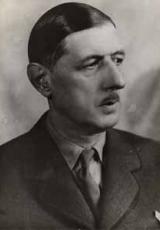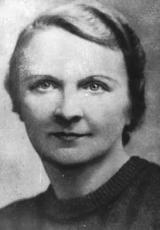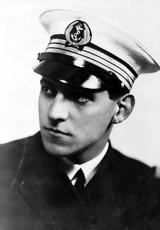Mont Valérien: a site of history and remembrance
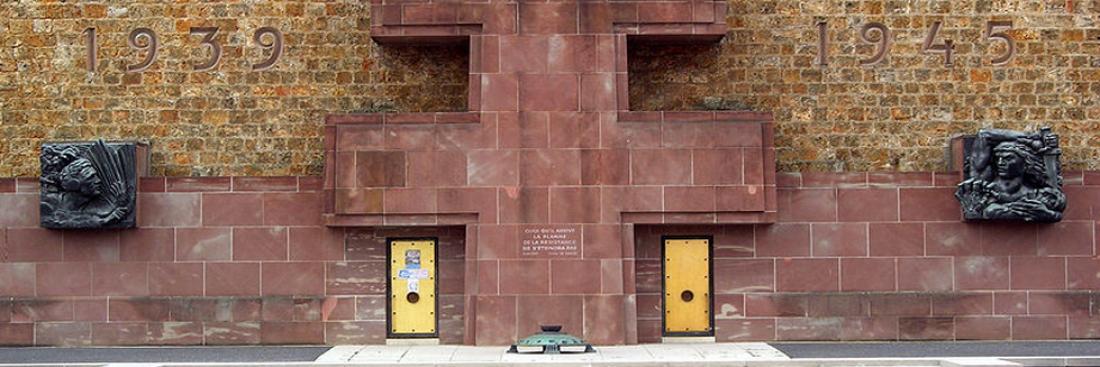
For centuries, Mont Valérien was an important Christian pilgrimage site. Then, in the mid-14th century, a fort was built there, as part of Paris’s defensive fortifications.
During the Second World War, it was used as the main execution site by the German authorities in France.
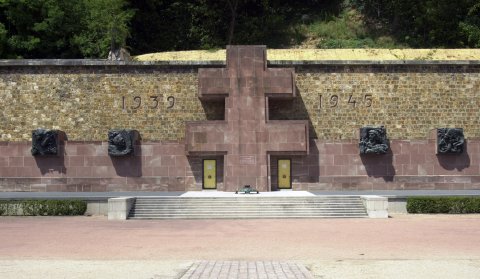
Memorial of Combatant France, Mont Valérien. Source: Jacques Robert - SGA/DMPA
After defeat and the armistice of 22 June 1940, France was divided into two zones: the northern zone was occupied by the German army, while the new “French State” was installed in the southern zone, in Vichy. The German military command in occupied France (Militärbefehlshaber in Frankreich – MBF) immediately put in place a repressive arsenal to ensure the security of its troops and the maintenance of order. In response to the initial acts of resistance from those who refused to accept the occupation, the repression was immediate and severe. In 1941, the MBF made Mont Valérien the Paris region’s site for the execution of Resistance fighters condemned to death by a German military tribunal, and later for the execution of hostages in retaliation for acts of aggression committed against its soldiers. From March 1941 to August 1944, over a thousand people were executed on Mont Valérien.
The execution site for the German military tribunals of Greater Paris
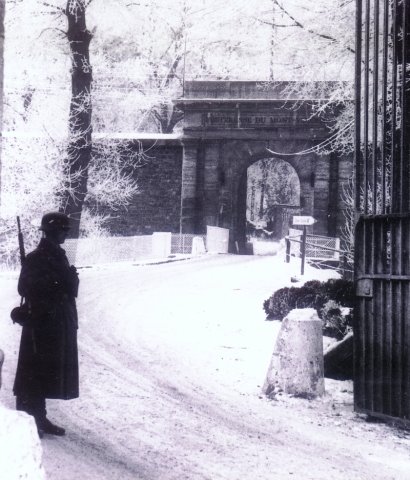
A German sentry guards the entrance to the fortress of Mont Valérien. Source: Suresnes History Society
Mont Valérien was first and foremost the execution site for the German military tribunals of the Seine department and, more broadly, across what the occupier referred to as Gross Paris, or ‘Greater Paris’ (which roughly corresponds to the present-day region of Île-de-France).
As early as autumn 1940, German repression took its first victims, but the first known execution at Suresnes came several months later, on 23 March 1941. A number of death sentences were carried out at other sites across the Seine department, such as Vincennes and Chatenay-Malabry, as Mont Valérien was not initially the German authorities’ preferred site.
The occupying authorities’ decision to make Mont Valérien its primary execution site appears to have been taken in late August 1941.
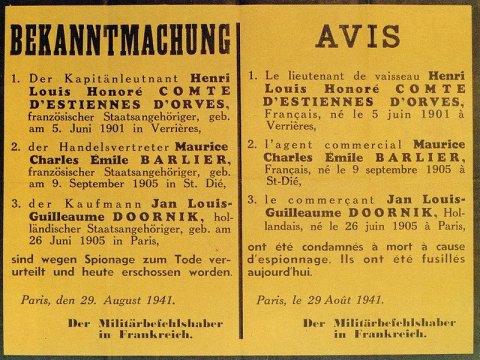
Notice of execution of d’Estienne d’Orves and his comrades by the occupier, 29 August 1941. Source: Museum of National Resistance collection, Champigny (Val-de-Marne)
On 26 and 27 August, five communist Resistance fighters were executed by firing squad there. On 29 August, it was the turn of three Gaullists – Honoré d’Estienne d’Orves, Maurice Barlier and Jan Doornick, of the Nemrod intelligence network. Until July 1942, executions took place at Mont Valérien at an increasing pace: 200 people condemned to death by Paris’s German courts were executed there.
In July 1942, the Germans began using an additional killing site: a former French army shooting range on Place Balard (15th arrondissement). From then on, the two sites were used jointly or alternately. Mont Valérien nevertheless remained the German military tribunals’ preferred site throughout the war: 61 executions in 1941, over 200 in 1942, approximately 180 in 1943 and more than 180 more in the first eight months of 1944.
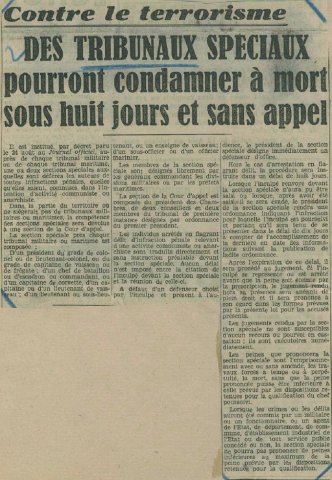
Extract from the collaborationist newspaper LaFrance au Travail (25 August 1941). Source: Archives Nationales
The site’s discreetness and its proximity to Paris, without being too close, appear to be the reasons behind the German preference for the fortress of Suresnes. Moreover, the cases tried in Paris, where the MBF was installed, involved Resistance fighters not only from Paris, but from the entire occupied zone.
In this way, the occupier asserted its pre-eminence over the Vichy authorities in the matter of law and order, and introduced active propaganda about its policy of repression aimed at intimidating the public. Nearly 40% of the more than 640 people executed by firing squad at Suresnes were arrested outside the department of Seine before being transferred to the capital for trial.
Hostage executions
Just as for those condemned to death, Mont Valérien was the main site in the occupied zone for implementation of the “hostage policy”.
From September 1941 onwards, for every attack committed against the occupying forces, a specified number of hostages would be executed in reprisals. The victims had to belong to the “presumed circle of the perpetrators of the attacks”, and therefore be from the same political, social and geographical milieux as them. In addition, the executions had to take place, as far as possible, in the areas where the attacks had been perpetrated.
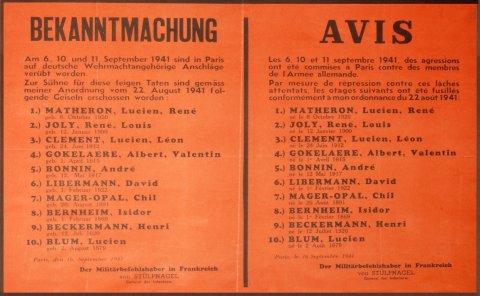
Notice of execution of hostages, 16 September 1941. Source: Museum of National Resistance collection, Champigny (Val-de-Marne)
This explains why all of the hostage executions of September 1941 in the occupied zone took place at Mont Valérien, since they were reprisals for attacks carried out in Paris by the communist resistance. On 6, 16 and 20 September, there were three executions by firing squad, with a total of 25 victims.
On 15 December 1941, one of the biggest mass executions of the whole occupation took place. In reprisals for a series of attacks on Paris and its suburbs since November, the MBF ordered the execution of 100 hostages. For the first time, the Jews were clearly singled out to bear the weight of these reprisals, alongside the communists. Unable to find the specified 100 hostages in the Paris area, 95 people were executed that day, 69 of them at Mont Valérien and the remainder in other departments of the occupied zone – nine from the Châteaubriant camp (Loire-Inférieure), four from Fontevrault prison (Maine-et-Loire) and 13 from Caen prison (Calvados).
At the beginning of 1942, the German authorities therefore faced the problem of always having an adequate reserve of hostages to execute in the areas affected by the armed struggle. Especially as, since the mass execution of 15 December, the MBF had decided to combine the executions with the systematic deportation to Germany of “Jewish Bolshevik” elements.
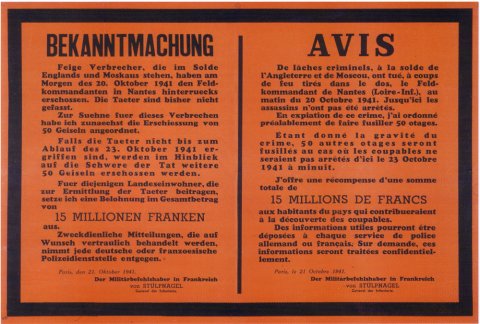
Notice of reprisals following the attack on Colonel Hotz in Nantes. Source: Museum of National Resistance collection, Champigny (Val-de-Marne)
Consequently, although large numbers of communists and Jews were being sent to the Parisian internment centres to be deported to Germany, the occupying authorities found themselves short of prisoners that could serve as hostages in the provinces.
The role of Mont Valérien as an execution site was indirectly reinforced as a result. As well as the reprisals ordered for attacks committed in the Paris area – which continued to increase until May 1942 – the German authorities of Greater Paris ordered executions at Mont Valérien to make up for the shortage of hostages in the provinces, which were similarly affected by attacks. The Drancy camp for Jews and the prisons of Fresnes, La Santé and Cherche-Midi for communists became hostage reserves on which the Germans drew for reprisal executions. Between February and the end of May 1942, over 60 people were executed at Mont Valérien for attacks carried out across the occupied zone.
Over 370 of the more than 730 people executed in France between September 1941 and October 1943 as part of the “hostage policy” were killed at Suresnes, i.e. one in two. But there were also executions in the “attached zone” of Nord-Pas-de-Calais. Altogether, the number of victims of executions in the northern zone and the attached zone exceeded 830.
Over 370 of the more than 730 people executed in France between September 1941 and October 1943 as part of the “hostage policy” were killed at Suresnes, i.e. one in two. But there were also executions in the “attached zone” of Nord-Pas-de-Calais. Altogether, the number of victims of executions in the northern zone and the attached zone exceeded 830.
An execution by firing squad at Mont Valérien
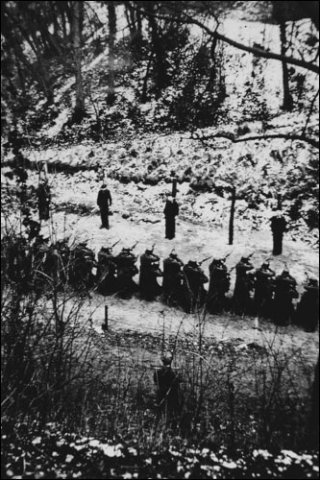
Photograph from a series taken in secret at an execution at Mont Valérien in February 1944, by non-commissioned officer Clemens Ruther.
Source: ECPAD; picture provided by the Association des Amis de Franz Stock
The executions followed a pre-established pattern. The prisoners were carried in army lorries into the grounds of the fort. At mass executions, like those of October 1943, some were clocked in the disused chapel, where they spent their final minutes. They etched messages on the walls, as their last testimony. In all cases, when they arrived at the clearing, an officer served notice on them in German of the sentence handed down by the tribunal that convicted them or the order designating them for execution as hostages. In small groups of three to five, they were tied to posts with their hands behind their backs, their eyes blindfolded if they wished. The firing squad (which could comprise up to 40 men) then shot them dead, sometimes in front of the comrades whose turn it was next. The German officer would administer the coup de grâce, then an army doctor would pronounce them dead.
Following the executions, the bodies were taken to various cemeteries in the Paris area, to be buried in mass or individual graves: mainly Ivry-sur-Seine, but also Suresnes, Puteaux, Bois-Colombes, Thiais, or Père-Lachaise, where they were incinerated. With the dispersal and anonymity of the bodies, the occupying forces sought to prevent the tombs from becoming rallying places and symbols of Resistance martyrdom.
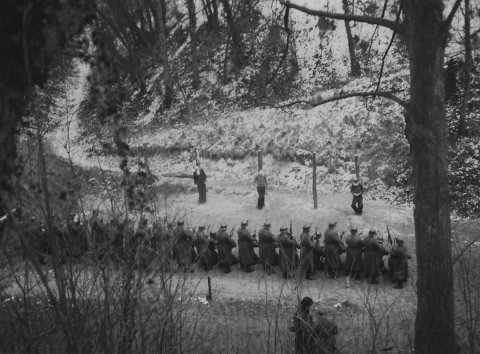
Photograph from a series taken in secret at an execution at Mont Valérien in February 1944, by non-commissioned officer Clemens Ruther.
Source: ECPAD; picture provided by the Association des Amis de Franz Stock
The role of the Romainville camp
In the spring of 1942, Hitler appointed General Oberg as supreme commander of the SS and police in France, and gradually withdrew the MBF’s prerogatives on repression, entrusting them to the SiPo-SD, the Nazi police. In August 1942, following an attack against German soldiers at the Jean Bouin stadium, General Oberg decided to resume mass reprisals. Ninety-three hostages were taken from the camps of Compiègne and Romainville and prisons of the Paris area, then reassembled at Romainville fort before being taken to Mont Valérien. On 11 August, 88 were executed, five not having been delivered to the execution site in time.
Realising that the grouping together of the hostages at Romainville did much to facilitate the reprisals, the SS made the fort the gathering place for the “scapegoats” being held on remand in the Paris area.
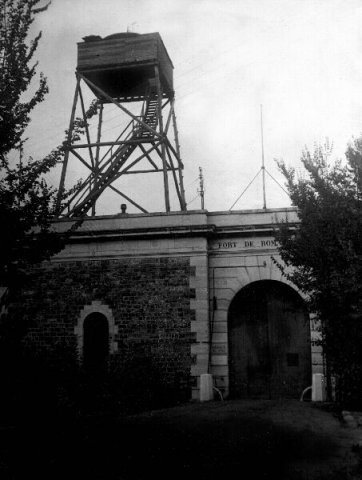
Entrance to Romainville fort. Source: SHD
On 21 September 1942, as a punishment for a new series of attacks, the Germans decided to execute 116 hostages. Forty-six people were taken from the Romainville camp to be executed at Mont Valérien; the other 70 were executed in Bordeaux, because the German authorities did not yet have sufficient hostages in Paris.
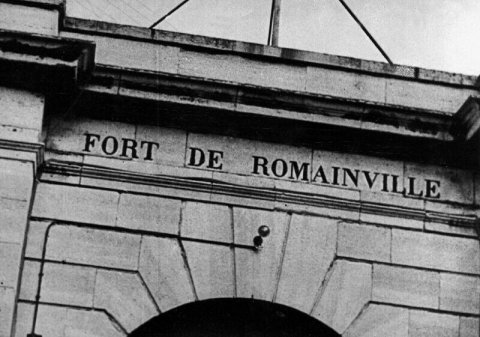
Romainville fort, where many hostages were executed by the Germans before the surrender of the garrison. Source: SHD
In autumn 1942, the Germans shelved the hostage policy, which they deemed ineffectual, as the attacks continued. Exceptionally, a further execution of hostages by firing squad was determined at the end of September 1943, in reprisal for the assassination of Julius Ritter, the German head of the labour service in France. On 2 October, 50 hostages were taken from the Romainville camp to Mont Valérien.
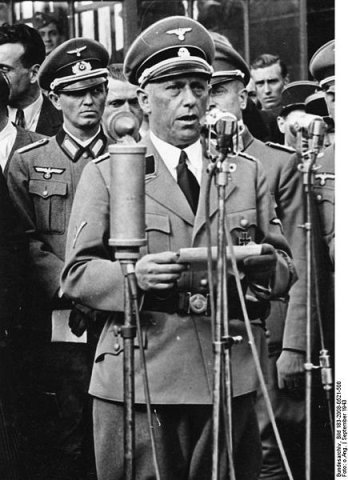
Julius Ritter, S.S.-Standartenführer and representative in France of the German commissioner-general for labour, September 1943. Source: Deutsches Bundesarchiv.
Altogether, 184 prisoners of Romainville fort were executed at Suresnes from August 1942 onwards. Using the Romainville camp as a single hostage reserve, in just three waves of executions the Nazi police executed as many hostages at Mont Valérien as MBF soldiers had done in the whole of the previous period.
Romainville, Compiègne, Drancy, Fresnes, Cherche-Midi, La Santé, Ivry-sur-Seine: prisoners passed through various sites en route to execution at Mont Valérien. All of these sites served a very precise purpose within the system of German repression and formed a network with Mont Valérien at its centre. Between 1941 and 1944, over a thousand people – prisoners sentenced to death and hostage scapegoats – were executed there, making Mont Valérien the primary execution site of the entire occupied zone.
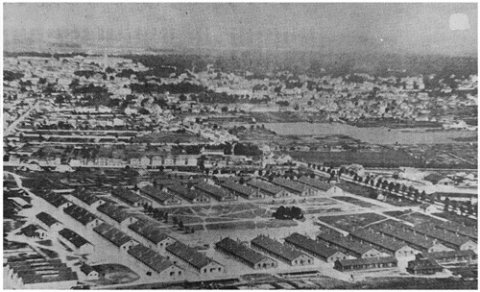
View of Compiègne-Royallieu camp. Source: Museum of National Resistance collection, Champigny (Val-de-Marne)
The liberation of the fort of Mont Valérien
On 20 August 1944, the Germans at Suresnes, joined by French militia, took refuge in the fortress. Following the fighting for the liberation of Neuilly, the Suresnes company of the FFI (French Forces of the Interior), comprised mainly of young Resistance fighters from Suresnes, Nanterre, Puteaux, Courbevoie and Boulogne, surrounded the fort. However, the commanding officer of the German troops refused to surrender to men without uniform. Colonel Rémy of the 1st Regiment of Moroccan Spahis (2nd Armoured Division), stationed at Longchamp, was called upon to negotiate. The Germans finally agreed to surrender. Just before the surrender of the fortress, the troops removed the five execution posts from the clearing, so as not to leave any traces. At 10.30 am on 26 August 1944, the French flag was hoisted at Mont Valérien.
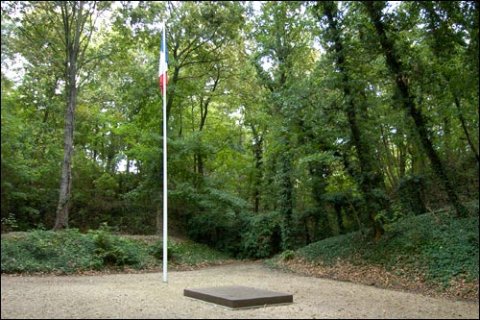
The execution clearing at Mont Valérien. Source: Claire Cameron – SGA/DMPA
On 1 November 1944, General de Gaulle delivered his All Saints’ Day tribute to the Resistance dead, first visiting the clearing at Mont Valérien, then the fort of Vincennes, then the cemetery of Ivry-sur-Seine, the main burial place of those executed by firing squad in the Paris region. Around the same time, the first remembrance ceremonies were organised by the associations of families of the executed, who wanted both to preserve the site – which was still in military control – and honour the memory of Resistance fighters and hostages.
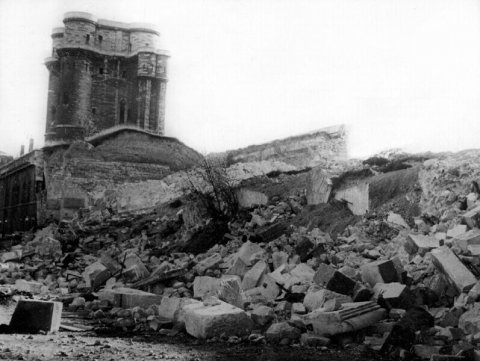
The fort of Vincennes, internal ruins. Source: SHD
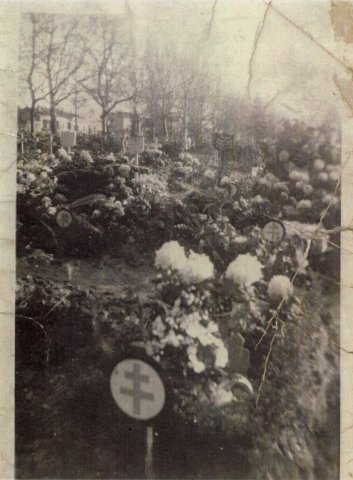
General de Gaulle visits the Carré des Fusillés at the Parisian cemetery of Ivry-sur-Seine, 1 November 1944.
Source: Mrs Charitas-Warocquier
Another execution site in Paris. The first execution of a Parisian by a German firing squad was at the fort of Vincennes. From 22 to 22 August 1944, 56 Resistance fighters, police and RATP transport workers were arrested and taken to Vincennes. Thirty-six of them were killed by firing squad in the fort’s moat and the disused La Cartoucherie munitions factory.
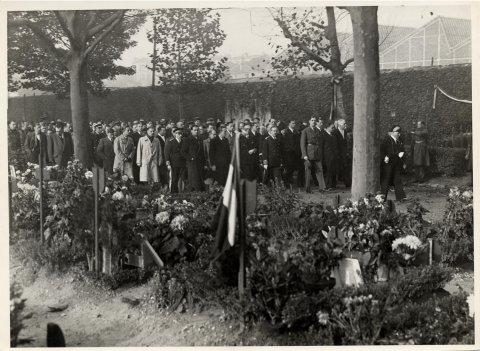
General de Gaulle visits the Carré des Fusillés at the Parisian cemetery of Ivry-sur-Seine, 1 November 1944. Source: Ivry-sur-Seine municipal archives
The ceremony of 18 June
On 18 June 1945, at the fifth anniversary celebrations of his call to arms from exile in London, General de Gaulle presided over the military parade on the Champs Élysées, before once again visiting Mont Valérien. The following year, determined to make this date and the Mont Valérien site a genuine monument of national remembrance, De Gaulle presided over a ceremony before the provisional crypt containing the remains of 15 heroes who “died for France”.
From then on, every year on 18 June, accompanied by the chancellor of the Order of Liberation, the Companions of the Liberation and a large crowd, General de Gaulle would relight the flame outside the provisional crypt. Meanwhile, true to the memory of their loved ones, the associations of families of the executed organised ceremonies and parades in the clearing, at which the names of those who died were remembered.
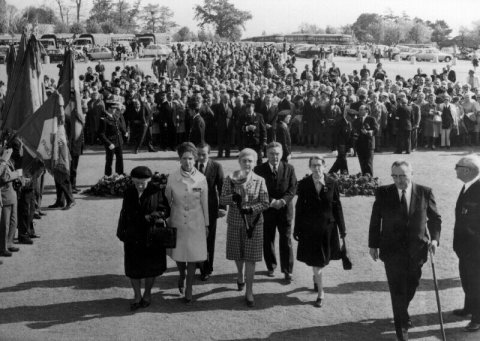
Mont Valérien. Ceremony in memory of those executed at Mont Valérien in 1942. Date: 1962. Source: SHD
Since 18 June 1960, the Esplanade de la France Combattante has been the site of a large number of ceremonies, in particular that commemorating General de Gaulle’s call to arms of 18 June 1940, organised under the aegis of the Chancellery of the Order of Liberation.
The ceremony brings together the most senior representatives of the French State, the Companions of the Liberation, their families and those of the deceased Companions, and representatives of the towns and military units awarded the Order of the Liberation.
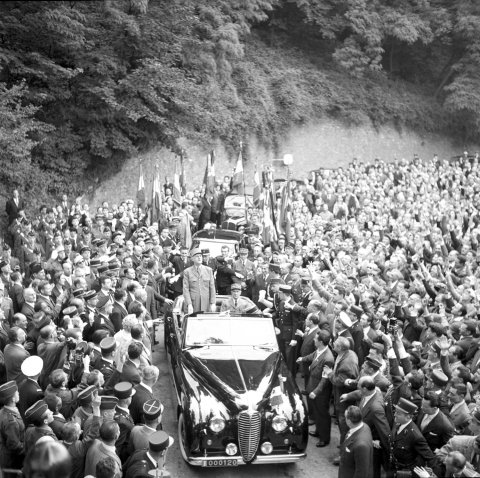
General de Gaulle arrives at Mont Valérien, 18 June 1958. Source: ECPAD
Since 2006, the official ceremony of 18 June has formed part of the annual national days of commemoration. Since then, the Ministry of Defence’s Directorate for Remembrance, Heritage and Archives (DMPA) has carried out improvement works at the site, aimed at providing the general public with the necessary resources for understanding such a complex and little known Major National Remembrance Site.
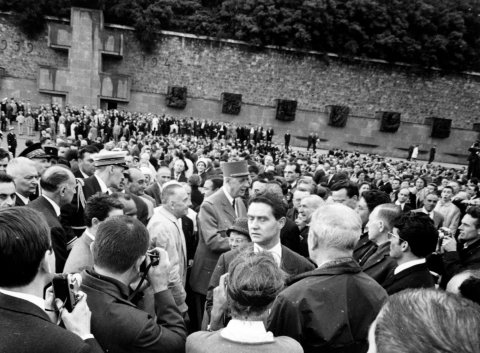
General de Gaulle arrives at Mont Valérien, 18 June 1958. Source: ECPAD.


